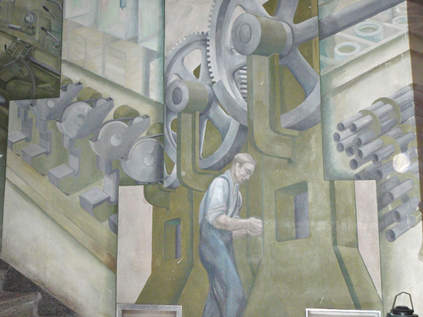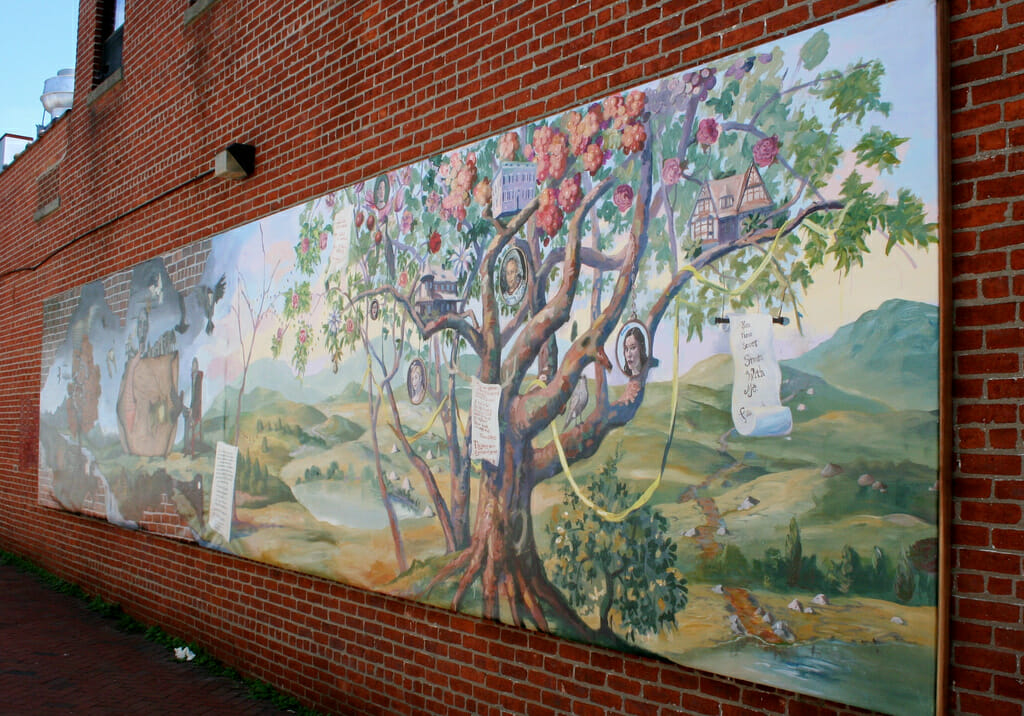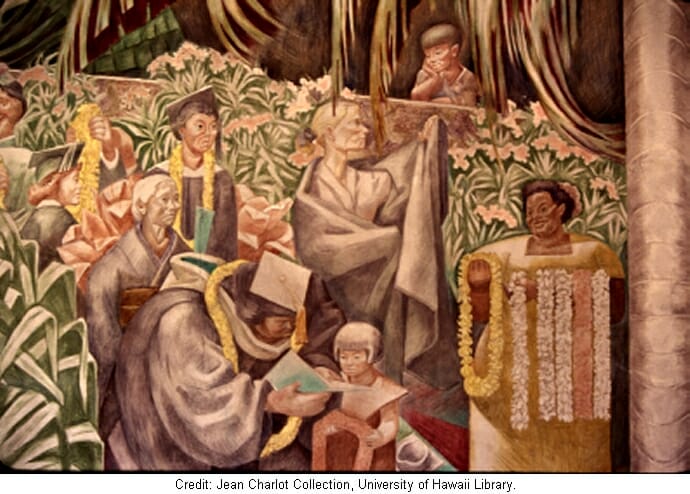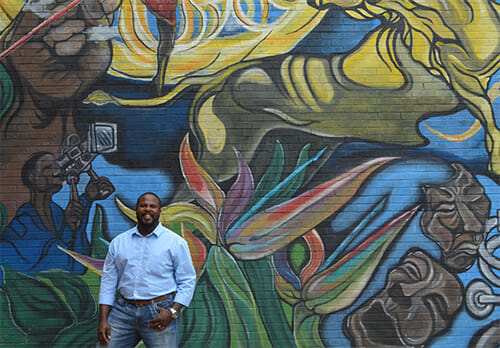The 25 Most Impressive University Murals
Art has fast become a representation of a college or university’s culture. For many schools this culture is what defines the artist of today. These following 25 significant murals were chosen based on several factors including their originality, their place on the campus, and the significance of the artist. Several of the murals in this collection were New Deal projects created through the Public Works of Art Program. At the other end of the time spectrum, some murals have been created in the 21st century using new technology. All of these murals say something about the people, places, or events that they represent.
25. Integral Spaces
Artist: Claire Him
University of Louisville, Louisville, KY
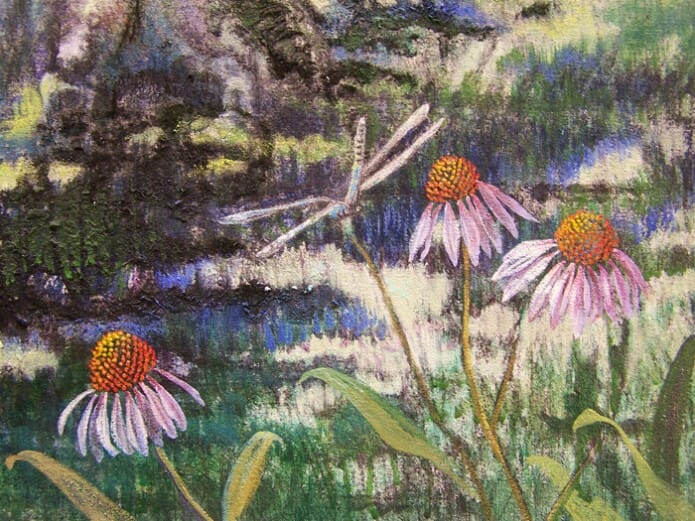
“Integral Spaces” is a four-panel mural created by Louisville artist Claire Him, who used layers of acrylics, charcoal and oil paints to create a feeling of nature inside the University of Louisville Physicians Group outpatient center. The layered materials and the subject matter of the mural also reflect the artist’s perspective of Louisville. Larry Cook, executive vice president for health affairs, says that the outpatient center has tried to create a warmer feeling than is typical in healthcare settings. Cook says that having a local artist create a welcoming piece of art contributed to that feeling of warmth.
24. Explosions in the Sky
Artist: David Teng Olsen
Wellesley College, MA
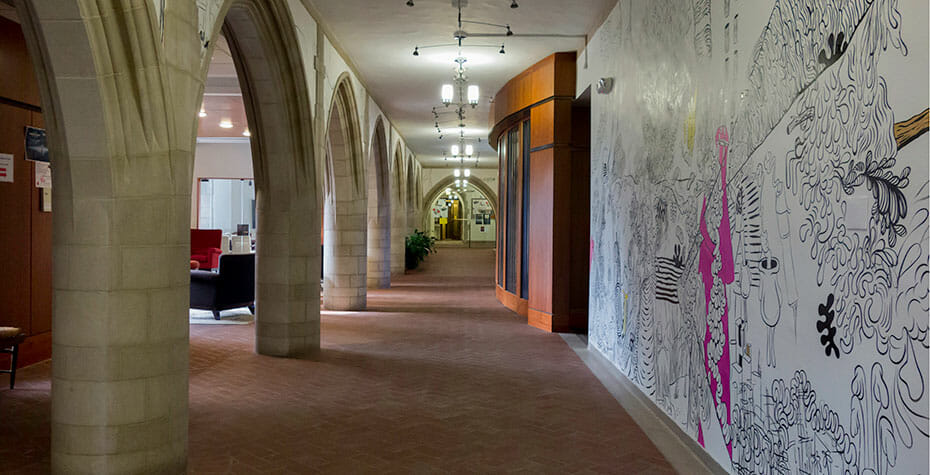
Assistant Professor of Art David Teng Olson created Wellesley College’s mural, “Explosions in the Sky,” in a burst of creative energy and activity lasting only two weeks. Olsen not only set his own deadline of two weeks, but also commissioned himself to create the mural. He asked if he could paint it, he recalls, “and they said…OK.” Olsen’s mural is a work of stream of consciousness, a series of marks flowing one from another. Some of the marks were requests from passersby. The child of a Wellesley faculty member asked if Olsen could include a giraffe. He could and he did. Olsen describes his mural as being “like a time capsule.” Link
23. The Kiss
Contributors: Jessica Banks and Daniel Paluska
Massachusetts Institute of Technology, MA
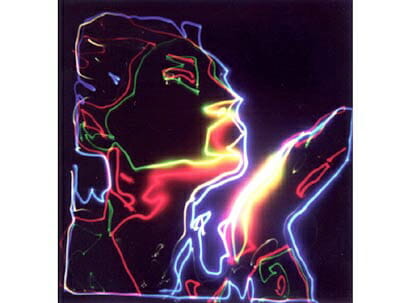
“The Kiss” fits comfortably in the Stata Center at MIT because it is a unique technologically designed mural that could perhaps have come into being only at MIT. While MIT graduate students Jessica Banks and Daniel Paluska refer to themselves as “contributors” of “The Kiss,” the true creator of this artwork is the Fotron 2000, a photo booth which contains a robotic arm which paints with light to create portraits. Exactly how this all works makes perfect sense to Banks and Paluska. For individuals less familiar with robotic arms and photo technology, it is sufficient to know that “The Kiss” was created by a computer with the aid of human contributors. Link
22. People of Color
Artist: Gabriel Guerriero
University of California, Santa Cruz/ College 9
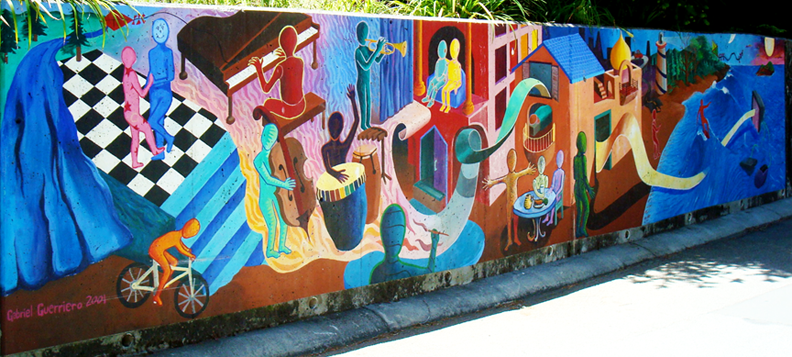
The University of California, Santa Cruz’s College 9 and College 10 host 27 murals. The university’s official murals page explains that the school welcomes questions, debate and discussion depicted in each mural. Each mural is unique to it’s intended discussion, for instance, a mural designed to resemble a page from a Where’s Waldo book, asks the question, “Where are the people at UCSC?”, another mural resembling the game Monopoly was designed to demonstrate the last ten years through events on a local, national, and global scale. The Monopoly mural, along with the mural shown, were the first murals in College Nine, before College Ten existed. The College Nine student government supported the painting of this mural and many students participated in painting the design. There was a showing of this mural on June 6, 2004. Link
21. Land-Grant Frescoes
Artist: Henry Varnum Poor
Penn State, PA
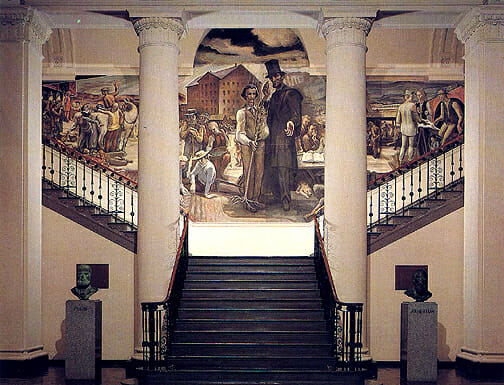
The Land-Grant Frescoes painted by Henry Varnum Poor, are actual frescoes. Poor’s daughter Anne applied fresh plaster to the walls in Old Main each morning and Poor painted directly on the wet plaster. Penn State’s frescoes pay tribute to the establishment of Penn State University and to the institution of land-grant education. A mural was proposed by faculty members in the 1930s. Poor was contracted to create the mural after the class of 1932 contributed a large sum toward the creation of the mural. Poor began sketches in 1939 and began painting in April, 1940. Poor returned to Penn State in 1948 to create two new murals on either side of the original. Link
20. Celebrating American Home-Front Workers
Artist: John M. Cadel
Judson University, Elgin, IL
Simpson Electric Co. in Elgin, IL occupied the former Illinois Watch Case Co. complex until the buildings were demolished in 2011. A historic mural from the plant’s lobby now graces the lobby of Elgin’s Judson University. The oil painting on canvas was created during World War II by John M. Cadel of Chicago and memorializes Illinois Watch Case Co.’s contributions to the war effort. The 13-by-11-foot mural portrays workers creating chemical mortar shells, pipes and gears meshing together. The Elgin Area Historical Society, which removed the mural from Simpson Electric Co., owns the mural but has signed a three-year display agreement with Judson. Judson art students cleaned the painting to prepare it for display after 70 years of display at Illinois Watch Case Co. and later Simpson Electric Co. Link
19. La Historia Chicana
Artist: Jesse Trevino
Our Lady of the Lake University, TX
As the first Mexican American to display art at the Smithsonian University, Jesse Trevino is a treasured artist. Trevino’s story of creating art involves far more than his country of origin. Trevino moved from Mexico to San Antonio as a young child and served his adopted country in the Vietnam War. During his overseas service the artist lost his right hand. Upon recuperation Trevino attended Our Lady of the Lake University to complete his bachelor’s degree in art. With help from Sisters Tharsilla Fuchs and Ethel Marie Corne Trevino learned to paint with his left hand. His first grand work as a left-handed painting was the 100 foot mural “La Historia Chicana,” which originally graced the walls of Our Lady of the Lake’s student union. “La Historia Chicana” now resides on the second floor of the Sueltenfuss Library, where a place was created for the mural during design and construction of the library. Link
18. The History of Montclair
Artist: Word Play
Montclair State University, NJ
Montclair State University’s Department of Art and Design maintains a mural project in Montclair, New Jersey which decorates the route between a business building and the building’s back parking lot. The original mural, installed in November 2011, was a 35-by-8 foot. painted canvas, “The History of Montclair,” which depicted Montclair’s history and people. A group of five individual works known as “Word Play” was installed on the opposite wall in June 2011. Super Storm Sandy ripped “The History of Montclair” off the wall in October 2012. It was replaced by “Painting Adversity,” a tribute to Montclair’s not-for-profit community organizations. Link
17. Commencement
Artist: Jean Charlot
University of Hawaii, Hawaii
The University of Hawaii’s mural “Commencement” hangs on the second floor of Bachman Hall on the Manoa campus. The 1953 Jean Charlot mural represents the shared values of the University of Hawaii system, including aloha, sustainability, collaboration, accountability, respect, innovation, intellectual rigor, leveraged technology, integrity, fairness, service, access, diversity and affordability. Link
16. Kentucky’s One and Only and Probably Last Fresco
Artist: Ann Rice O’Hanlon
University of Kentucky, KY
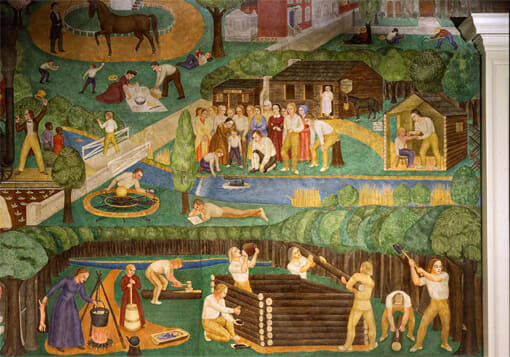
Ann Rice O’Hanlon’s fresco in Memorial Hall at the University of Fresco, called by O’Hanlon “Kentucky’s one and only and probably last fresco,” has a unique and interesting story. Born in 1908 in Ashland, Kentucky, O’Hanlon studied art in Kentucky and California and taught art at several colleges, including Georgetown University. O’Hanlon created the fresco as part of President Roosevelt’s Public Works of Art program. O’Hanlon initially wanted to create a fresco in the state of Kentucky which included geography, geology and agriculture. The final mural is rectangular rather than shaped like Kentucky and features historical scenes from Kentucky’s long past. O’Hanlon painted the fresco and her husband did the plaster work. Link
15. Touchscreen Video Wall Mural
Digital Artist: Olga Mayer
Central Washington University, WA
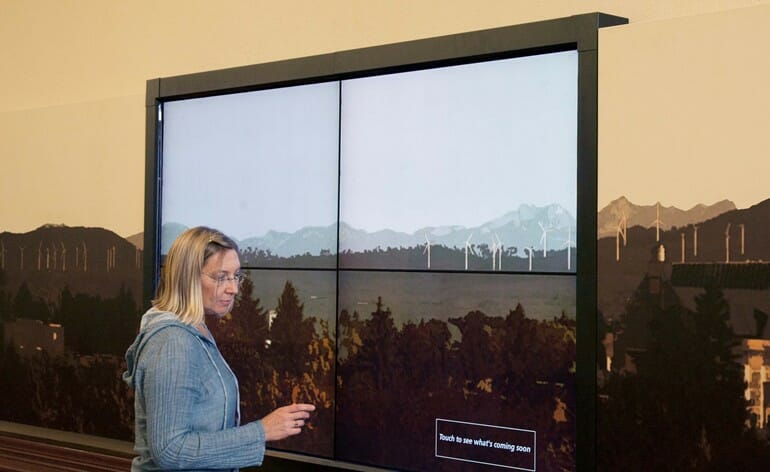
Central Washington University’s latest mural brings together art and technology in the form of a 2-by-2 foot touchscreen video wall. The wall outside the university president’s wall once featured framed photos of CWU faculty members. These images were replaced with a panoramic image of the area. The video screen sits in front of the panorama, creating a pleasing artistic arrangement. The video screen uses a 46 inch LCD display with six-point touch features and controls similar to those found on an iPad. When the screen is not playing photos and video clips it displays an image that blends into the panoramic image which frames it.
14. Missouri
Artist: Thomas Hart Benton
University of Missouri, MO
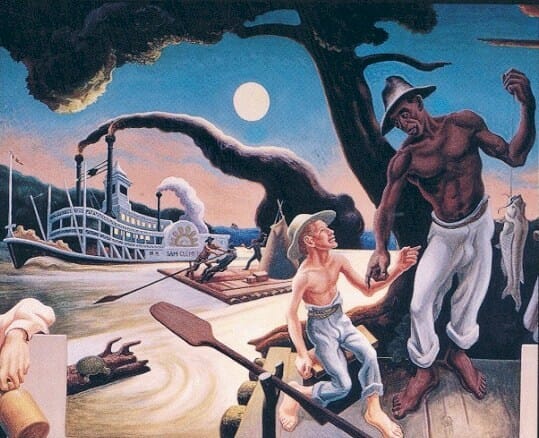
Thomas Hart Benton was Missouri’s greatest muralist and one of the most accomplished muralists of all time. Benton’s murals of life in Missouri around the time of the Civil War adorn the House Lounge in the Missouri state capitol building. Many decades after Benton’s death, a new Thomas Hart Benton mural has been created. This new mural comes in the form of a documentary, “Tom Benton’s Missouri,” featuring Benton’s artwork and singer Bob Dyer’s ballads of Missouri history. The film debuted in 2002, was broadcast on PBS and was distributed to schools in VHS format with teaching resources on floppy disk. In 2012 the film was digitally remastered and is available for free download from the University of Missouri Extension office, which also offers several free classroom resources. Link
13. Engineering
Artist: Raymond Jonson
University of New Mexico, NM
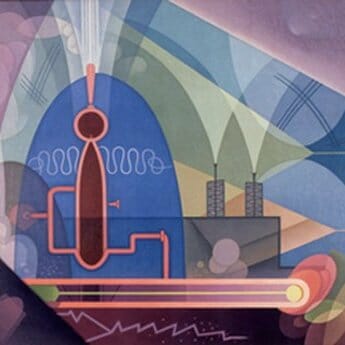
The University of New Mexico’s mural “Engineering” features a brightly colored rocket-like shape juxtaposed against an industrial building. The 60” by 71” mural is part of the “Cycle of Science” series produced for the UNM library in 1934. “Engineering” was created by artist Raymond Jonson as part of the Public Works of Art Project and is now part of the Raymond Jonson Reserve Retrospective Collection at the University of New Mexico Art Museum. Link
12. Making of a Fresco
Artist: Diego Rivera
San Francisco Art Institute, CA
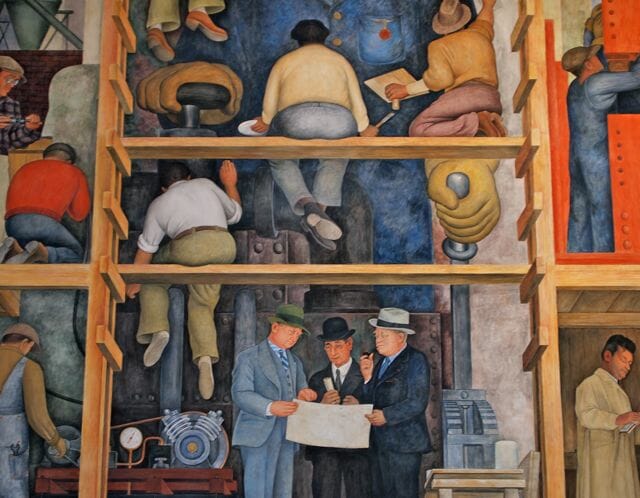
Diego Rivera’s 1931 mural at the San Francisco Art Institute is two frescoes in one. “Making of a Fresco” is a fresco itself. The second fresco is the fresco being created by the people in the outer fresco. One of four Rivera murals in the Bay Area, “Making of a Fresco” presents a challenge to the viewer to find the imagined fresco within the outer fresco. Rivera filled his fresco with recognizable people who played a part in creating the fresco. This mural delights viewers with its mix of realism and illusion.
11. United Farm Workers of America
Lead Artist: Carlos “Cookie” Gonzalez
San Francisco State University, CA
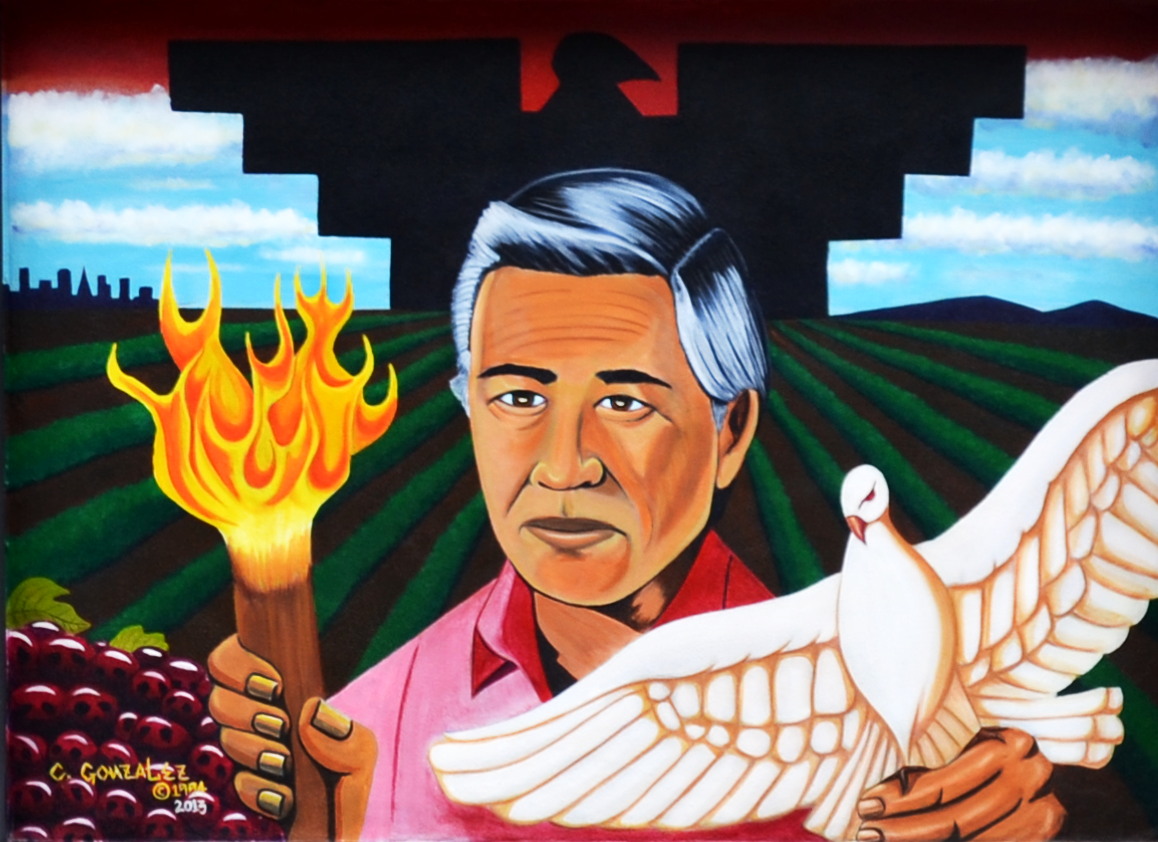
San Francisco State University’s Cesar Chavez mural resides in the SFSU Student Union, which is now named after Chavez. The five elements of the Cesar Chavez mural represent Chavez himself, the United Farm Workers of America, founded by Chavez, a flaming torch in Chavez’s right hand, a dove in Chavez’s left hand and the grapes of wrath. The colors of the mural represent different aspects of Chavez’s work. Black represents struggle. Red represents sacrifice. White represents hope. The eagle behind Chavez represents the United Farm Workers of America. The dove symbolizes non-violent resistance. The torch represents Chavez’s inspirational leadership, and the “grapes of wrath,” which resemble skulls, symbolize the harmful and often deadly effects of chemical pesticides on farm workers.
10. Labor
Artist: John Soca
Winona State University, MN
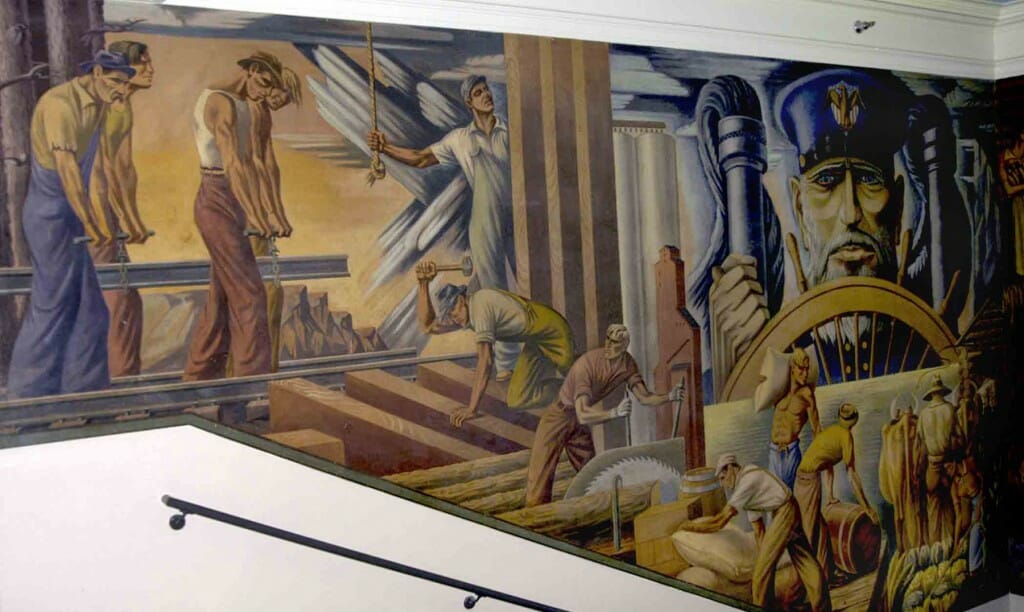
Somsen Hall, located in Winona State University, MN, is the home to a historic mural, painted in the second-floor entrance during the Great Depression by artist John Martin Socha. This mural was created with the support of the WPA (Work Progress Administration). The mural represents a pioneer’s life. It includes scenes of farmers, loggers, railroad workers, a riverboat captain and Native Americans all hard at work. Somsen Hall was recently added to the National Register of Historic Places which contains more than 80,000 historic sites across the country. Link
9. Where We Come From…Where We’re Going
Artist: Olivia Gude
University of Chicago, IL
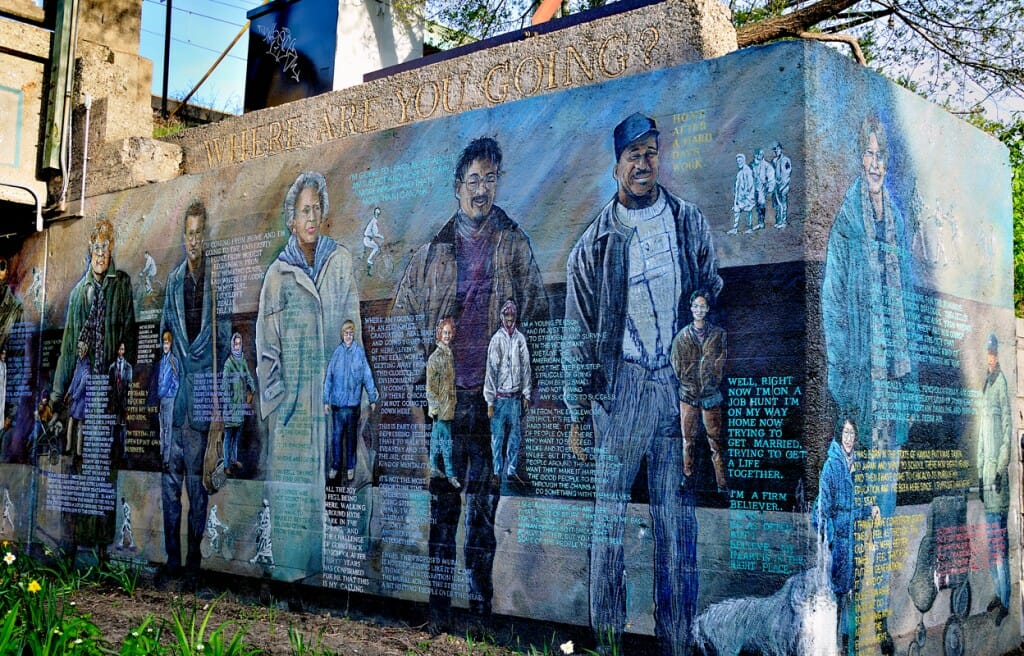
Some universities have murals dating back to the New Deal and the Works Progress Administration. In Chicago, murals are a much newer form of art. Olivia Gude’s “Where We Come From…Where We’re Going,” at the intersection of 56th Street and Lake Park Avenue, is one of the earliest murals in the city. Gude created the mural in 1982. Now more murals have been installed in Hyde Park and older murals have been updated and restored to create a new look and feel in five Metra underpasses on Lake Park Avenue. Gude describes the murals as a part of Chicago’s “deep culture of community connection, of high social capital, with people being kind to each other in public spaces.” Link
8. Art Factory
Artist: Hasaan Kirkland
Johnson C. Smith University, N.C
Hasaan Kirkland is an associate professor of fine art at Johnson C. Smith University and is the artist who created this mural for the visual and performing arts program. The mural depicts what happens in the program and, as quoted by Kirkland, “Something that I really wanted to contribute to the school.” This is Kirkland first public art piece which he describes as “a newer form of imagery that can be representational or abstract”. Link
7. Roots of the Caribbean
Artist: Jorge Morales
Central Connecticut State University, CT
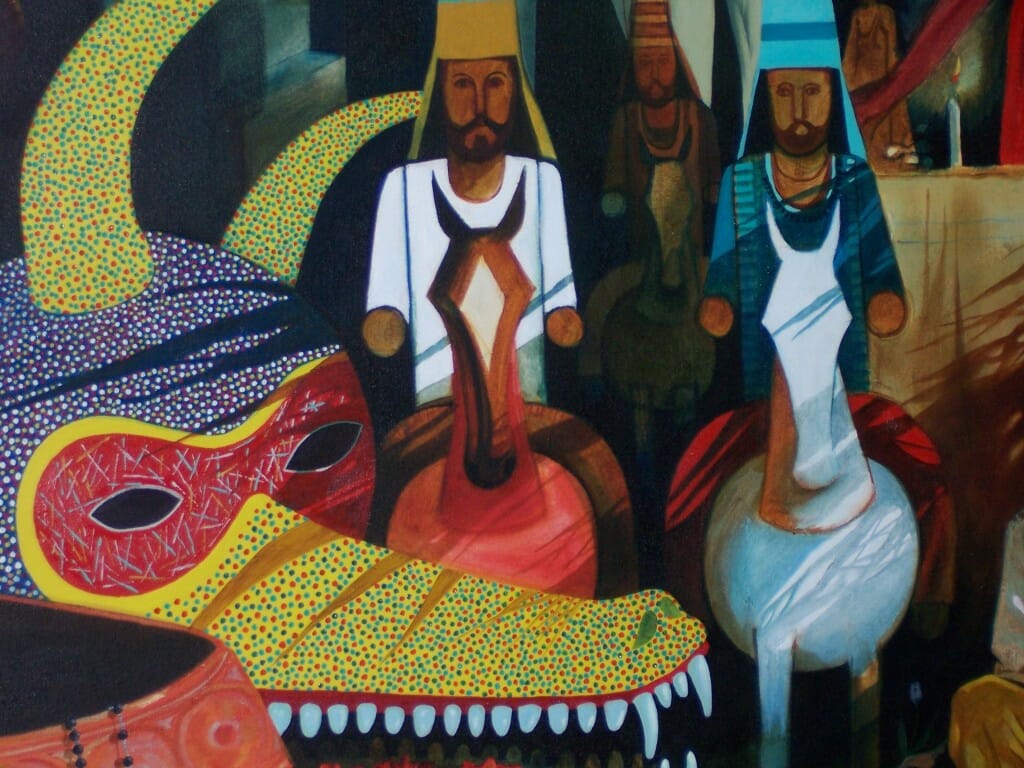
At Central Connecticut State University, murals abound. The university has one of the largest collections of murals in the United States. This collection of murals makes CCSU the perfect university to offer a mural painting program. Creating a mural, from the first such creation through works currently in progress, is by necessity a collaborative process. In CCSU’s Mural Painting Program, which is distinct from other fine arts programs, students work together and with faculty and staff. In addition to learning the history and techniques of mural painting, CCSU mural students create murals which become part of a unique collection unlike anything else in the country. Link
6. Face Up
Artist: Pauli Murray
Duke University, NC
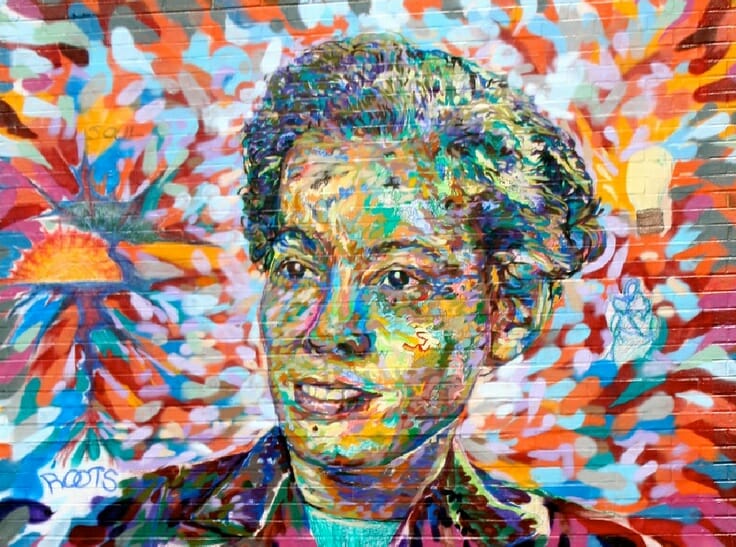
Between 2007 and 2009, more than 1,500 people in Durham, North Carolina engaged with a collaborative art project called “Face Up: Telling Stories of Community Life.” The murals from this unique project now grace the exterior walls of publicly accessible businesses, schools and other buildings in downtown and Southwest Central Durham. The collaboration involved children from toddlers through elementary students, students in middle school, high school and college, professors, area residents and elders, of all social classes and ethnic groups. The faces in “Face Up: Telling Stories of Community Life” represent every aspect of community life in Durham.
5. Living History
Artist: Students Over Several Decades at Kettering University
Kettering University, MI
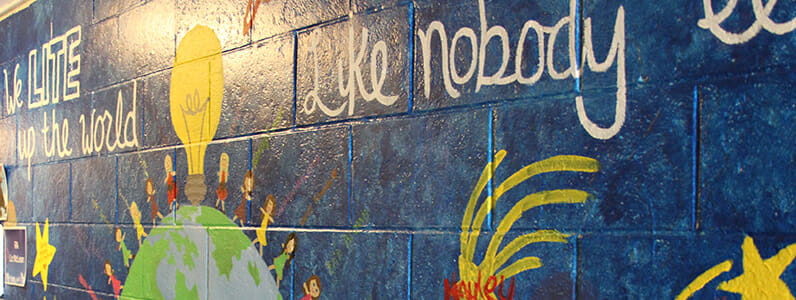
Murals often grace public buildings or adorn public walkways and walls. At Kettering University, murals extend into a more private part of the school as students adorn the walls of their residence hall with murals. Students in Thompson Hall add four or five murals to the walls in an average year. Teams of students create a design plan, which the residence hall association must approve before work begins. Mural teams create paintings ranging from original designs to pop culture icons and cartoons. Each member of the team adds his or her name to the mural. Many prominent Kettering alumni have signed murals in Thompson Hall. Link
4. Taylor Hall
Artist: John Pugh
Chico State University, CA
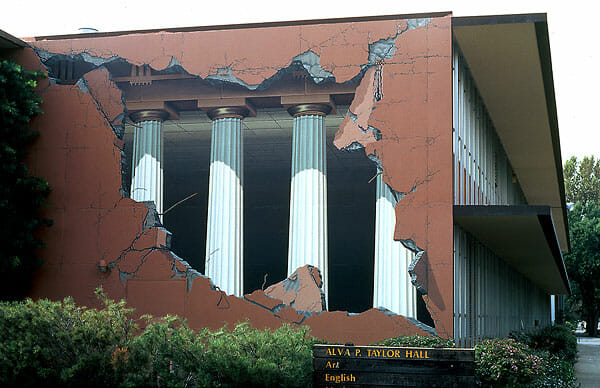
A first-time visitor to Taylor Hall, on the campus of Chico State University, could be forgiven for thinking that the building has recently suffered major damage. John Pugh’s Trompe l’oeil painting on the side of Taylor Hall depicts the side of the building crumbling to reveal Doric columns. This extremely realistic and thought-provoking mural was John Pugh’s first major commission. The Taylor Hall mural brought Pugh international recognition and energized his career. Pugh has since become a widely recognized artist. Taylor Hall has become a major landmark in Chico and has influenced the creative tone and nature of the community. Link
3. Parks, the Circus, the Klan, the Press
Artist: Thomas Hart Benton
Indiana University, IN
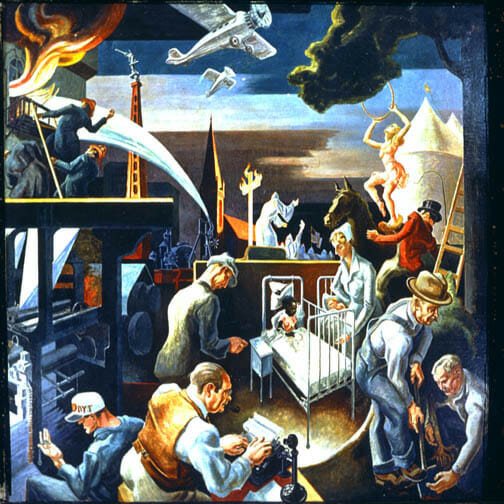
Thomas Hart Benton is the only muralist to have two works in the list of most important university murals. Benton created a six-mural cycle that served as Indiana’s exhibit in the Chicago World’s fair in 1933. Benton declared the sequence of six paintings the largest mural cycle ever attempted. The murals, which depict Indiana history, occupy 2,600 square feet. Painting an average of 38 square feet each day, Benton planned, researched and completed the murals in only six months. After their completion they proved so large as to create transportation difficulties. A new opening had to be created to remove them from the gallery where Benton created them. A highway bridge on the route to Chicago was too low for the murals to pass underneath. A fairgrounds gate had to be taken down to allow the murals in. The murals now reside in Woodburn 100 on the Indiana University campus. Link
2. Word of Life
Artist: Millard Sheet
University of Notre Dame, IN
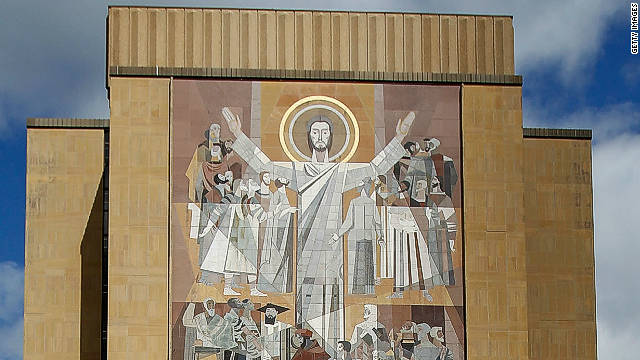
When the University of Notre Dame’s Hesburgh Library opened, it did not yet host the distinctive mural which now adorns the exterior wall. That mural had been commissioned, to be completed by Millard Sheet. The commission for the mural stated that it should be large enough to cover the southern face of the Hesburgh Library tower, that it should be visible from the football stadium and that the theme should be saints and scholars throughout the ages. The mural is officially called the “Word of Life” mural, but is often called ”Touchdown Jesus” because of its depiction of Christ the Teacher with arms raised. Link
1. Gesling Stadium
Artist: Douglas Cooper
Carnegie Mellon University, PA
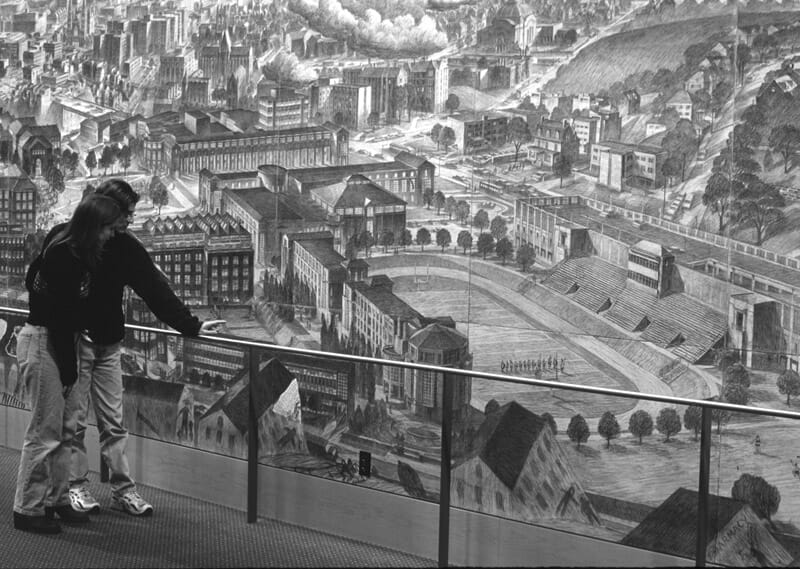
Douglas Cooper’s murals in the Rotunda of the University Center at Carnegie Mellon University serve as an orientation to the campus and the city and to multiple time periods in the university and the region. Each wall of the rotunda contains one full mural. All of the murals together also form one full mural. The Eastwall Mural depicts Oakland, Pennsylvania and the college then known known as Carnegie tech during the years 1945 to 1965. The opposite mural, the Westwall Mural, depicts the present and future Carnegie Mellon campus. The Northwall Mural depicts Pittsburgh in the present time. The murals are created as detailed architectural drawings in black and white. Link
